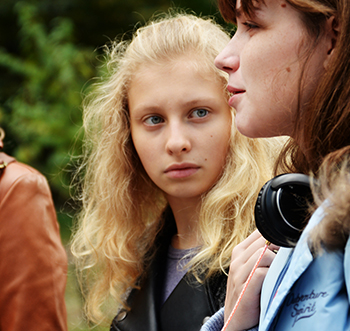
Sofia Daragan
Among many things that are hard to imagine, a site of massacre and mass murder is one of them. Even when that site is not that far away.
As one of the youngest interns with the new Babi Yar IWalk - an educational program that put on a walk around the Babi Yar ravine in Ukraine guided by testimony clips from the Visual History Archive - 14-year-old Sofia Daragan did not know much about the ravine until she was invited to help lead the walks.
“My first time there was with the IWalk,” Daragan said. “I had imagined it differently. I thought it was a huge ravine and that there was a museum.”
But it’s not, and there isn’t one. The site of one of the largest mass murders at a single location during World War II, the Babi Yar ravine is small, quiet and often forgotten. There, in the span of one week in 1941, SS, German police units and their auxiliaries shot nearly 34,000 Jews from Kiev to death. Later, they would kill tes of thousands more Roma, Communist and Soviet prisoners in the same fashion.
For the over 100,000 killed in total at the ravine, 100 testimonies mentioning the ravine and massacre live on in the Visual History Archive. Along the IWalk, participants - high school students and community members - were able to walk through the historic site and through the Babi Yar memorial while watching those testimony clips from the archive on tablet devices.
Daragan said what drew her into the program was her desire to spread what she was learning to her community members.
“It is important for me that such tragedies be remembered,” Daragan said. “And if I have an opportunity to help [my community] learn about it, it is my pleasure to use that opportunity. IWalk is a great opportunity to learn.”
Daragan was one of just 10 high school students and five young educators trained by USC Shoah Foundation Ukraine regional consultant Anna Lenchovska to lead the Babi Yar IWalk. Recruited because of their involvement with TolerSpace, a Kiev-based NGO developed in 2013 as part of a series of projects promoting tolerance under the Congress of Communities of Ukraine to create an educational space around discussion of human rights and tolerance, Daragan and the other leaders went through training under Lenchovska to prepare them to lead IWalks between Sept. 26 and Oct. 7.
“At first, I was worrying a lot because the first group [I would lead] would be my peers,” Daragan said. “And I thought they may not perceive me as an information source and that they wouldn’t bother answering my questions. But it turned out very differently and I am very glad about it.”
She was also prepared to deal with any “bully reactions” from participants who wanted to detract from the powerful experience. Daragan said she believes physically walking and listening to testimony on tablets and to leaders explaining history enhanced the experience for participants.
“I like working with testimonies on tablets,” Daragan said. “And that teenagers can learn from the actual people who had survived by miracle in Babi Yar. I also liked being a mediator between the information and the group. I think it is important to know about places of memory.”